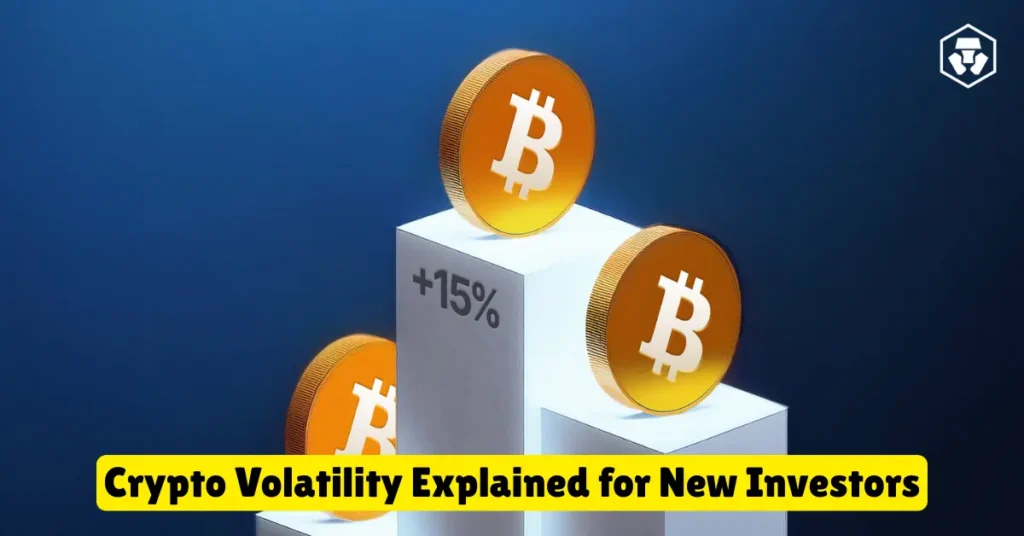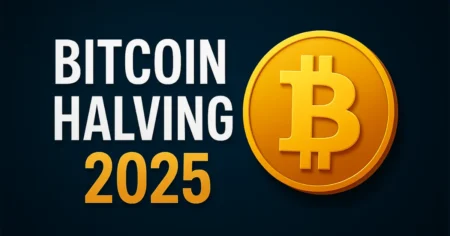Crypto Volatility Explained for New Investors
Introduction
If you’re new to the world of cryptocurrency, you’ve probably noticed how often people talk about its prices going up and down. One day Bitcoin is soaring, and the next day it’s dropping fast. This rapid change in prices is called volatility, and it’s one of the things that makes crypto exciting but also confusing for new investors.
In this blog, we’ll explain what crypto volatility means, why it happens, and how you can deal with it as a beginner. Whether you’re thinking about investing or just curious, this guide will help you understand the basics without getting lost in technical terms.
What is Volatility in Crypto?
Volatility means how much the price of something goes up or down in a short period. In the case of cryptocurrency, it refers to how quickly and sharply the value of coins like Bitcoin, Ethereum, or others can change.
For example, if Bitcoin is worth $30,000 today, but drops to $27,000 tomorrow and then rises to $32,000 the day after — that’s a sign of high volatility.
Crypto is known for these big price swings, often happening within hours or even minutes. This makes it very different from more stable assets like gold or traditional stocks, which usually move at a slower pace.
Volatility can be both an opportunity (for making profits) and a risk (because prices can crash suddenly). That’s why new investors need to understand what it means before jumping in.
Why is Crypto So Volatile?

Cryptocurrencies are famous for their wild price swings, but why does this happen so often? Unlike traditional assets like stocks or bonds, the crypto market behaves very differently. Let’s break down the main reasons behind crypto’s high volatility:
Crypto is Still New and Evolving
The cryptocurrency market is still very young compared to traditional financial markets like stocks or real estate. Most people and institutions are still figuring out how it works. Because the market is small and developing, even small changes in demand, news, or trading activity can cause big price moves.
In short, a smaller market = bigger impact from fewer trades.
High Speculation and Hype
A lot of people invest in crypto based on emotions, news, social media trends, or fear of missing out (FOMO). They’re not always looking at the real value or use of a coin — they’re trying to make quick money.
- When investors act on hype instead of facts, prices can shoot up quickly. But when that hype fades, prices fall just as fast. This kind of emotional buying and selling leads to extreme volatility.
Lack of Regulation
- Unlike stock markets, which are heavily regulated by governments and financial authorities, the crypto world has many fewer rules. This makes it easier for price manipulation to happen — for example, “whales” (people or groups holding large amounts of crypto) can move the market by making big trades.
- Also, when there’s a rumor about new laws or government bans, people panic and start selling quickly, causing sharp price drops.
24/7 Global Trading
Unlike traditional markets that close at night or on weekends, crypto markets never sleep. They’re open 24/7. That means prices can change anytime, including during off-hours when fewer people are trading, making it easier for big swings to happen with less trading volume.
Uncertain Future and Rapid Innovation
- The technology behind cryptocurrencies is constantly changing. Sometimes a project introduces a major upgrade or a new feature, which boosts investor confidence and raises prices. But if a project runs into technical issues or security problems, the price can crash.
- Also, since many cryptocurrencies are still unproven in the real world, their future is uncertain, and uncertainty always leads to more volatility.
Media and News Impact
The crypto market reacts strongly to news, both positive and negative. A tweet from a well-known figure, an exchange hack, or a government policy change can cause panic or excitement instantly.
For example:
- Positive news, like a country accepting Bitcoin as legal tender, can boost prices.
- Negative news, like a major crypto ban, can trigger panic selling.
Volatility Isn’t Always Bad
Many new investors hear the word “volatility” and immediately think it’s something negative. While it’s true that extreme price swings can be risky, volatility also brings opportunities — especially for those who understand how the market works.
Let’s explore both sides of volatility and why it’s not always a bad thing.
Volatility Creates Profit Opportunities
Volatility simply means prices move, and when prices move, there’s potential to earn.
For example:
- If you buy a coin at $100 and it rises to $150, you’ve made a 50% profit.
- These kinds of gains are possible in crypto because prices can change very quickly.
This is one reason why day traders and short-term investors love crypto. They aim to take advantage of frequent price changes to earn fast profits — something that’s harder to do in more stable markets like stocks or real estate.
Essential for Market Growth
- Volatility is a sign that the market is active and alive. In the early stages of any new technology or industry, volatility is normal. It reflects the process of finding the true value of an asset.
- Crypto is still in its growth phase. As it evolves and becomes more widely adopted, price movements help investors, developers, and companies test the real value of different projects.
- Without volatility, the crypto market would be slow and possibly stagnant.
It Helps Spot Market Trends
When prices move sharply, it often gives clues about investor sentiment:
- A sudden rise might indicate growing trust in a coin or project.
- A sharp drop could point to problems, panic, or uncertainty.
Volatility helps experienced investors read the market better. Even long-term investors use short-term volatility as a tool to identify good entry points (buying when prices are low) or exit points (selling when prices are high).
You Don’t Have to Act on Every Swing
One of the biggest myths is that volatility means you always have to trade or react. That’s not true.
- If you’re a long-term investor, volatility is simply part of the journey. The crypto market has gone through many ups and downs, and over time, many major coins have recovered and grown significantly.
- Smart investors don’t panic during every dip. They focus on their goals, hold their investments, and trust the long-term vision of the projects they believe in.
It Builds Stronger Investors
Volatility teaches patience, discipline, and emotional control — qualities every successful investor needs. Dealing with price swings helps you:
- Avoid making decisions based on fear or greed
- Stick to your investment strategy
- Learn how markets behave over time
Facing volatility early on can prepare new investors for any financial market in the future.
How to Handle Volatility as a New Investor: A Complete Guide

Cryptocurrency volatility can be intimidating for new investors, but with the right approach, you can manage risk and even take advantage of price swings. This step-by-step guide will help you handle crypto volatility effectively, from beginner tips to advanced strategies.
Start Small: Invest Only What You Can Afford to Lose
The first and most important rule is to never invest money you can’t afford to lose. Crypto prices can drop suddenly, so protect yourself by:
- Using only a small portion of your savings for crypto
- Avoiding loans or credit to buy cryptocurrencies
- Setting realistic expectations for gains and losses
Understand Your Risk Tolerance
Everyone reacts differently to market ups and downs. Ask yourself:
- How much price fluctuation can you handle without panic?
- Are you comfortable holding through big drops?
- Knowing your risk tolerance helps you choose investments and strategies that fit your personality.
Think Long-Term: Avoid Panic Selling
Volatility often causes fear and emotional reactions. One common mistake is panic selling when prices drop. Instead:
- Focus on the long-term vision of your investments
- Remember that many cryptocurrencies have recovered after big dips
- Use downturns as potential buying opportunities rather than reasons to exit
Diversify Your Portfolio
Don’t put all your money into one coin. Spread your investments across different cryptocurrencies and other asset types to reduce risk. Diversification helps cushion the impact of any single coin’s price crash.
Use Dollar-Cost Averaging (DCA)
DCA means investing a fixed amount of money at regular intervals regardless of price. This strategy:
- Reduces the risk of buying at a high price
- Helps you build your position gradually over time
- Removes emotional decisions linked to market timing
Set Clear Goals and Exit Strategies
Before investing, define your goals:
- Are you looking for short-term profits or long-term growth?
- At what price will you sell to lock in profits or cut losses?
- Setting targets helps you stay disciplined and avoid emotional trading.
Stay Informed but Avoid Overreacting
Keep up with news and market trends, but don’t react instantly to every headline or social media hype. Verify information from reliable sources before making decisions. The crypto world is full of rumors and misinformation that can cause unnecessary panic.
Use Stop-Loss Orders and Limit Orders
Advanced investors can use tools like stop-loss orders to automatically sell an asset if it drops to a certain price. Limit orders let you buy or sell at your chosen price instead of the market price, helping you control entry and exit points more precisely.
Keep Emotions in Check: Practice Patience and Discipline
Volatility tests your emotional control. Avoid decisions based on fear, greed, or FOMO (fear of missing out). Stick to your plan and don’t chase quick gains or panic during dips.
Regularly Review and Adjust Your Strategy
Crypto markets change fast. Periodically review your investments and goals:
- Are your holdings still aligned with your risk tolerance?
- Has the market environment changed?
- Adjust your portfolio and strategy as needed, but avoid overtrading.
Consider Professional Advice or Education
If you’re unsure, consider:
- Consulting with financial advisors experienced in crypto
- Taking courses or reading trusted resources to deepen your knowledge
- Being well-informed reduces risk and increases confidence.
Summary: Key Takeaways for Managing Crypto Volatility
Invest only what you can afford to lose
- Know your risk tolerance
- Focus on long-term goals and avoid panic selling
- Diversify your portfolio
- Use dollar-cost averaging for steady investment
- Set clear goals and exit plans
- Stay informed, but don’t overreact
- Use advanced tools like stop-loss and limit orders wisely
- Control your emotions and remain disciplined
- Regularly review and adapt your strategy
- Seek professional advice or education if needed
By following these steps, new investors can handle crypto volatility with greater confidence and reduce the risks that come with this exciting but unpredictable market.
Common Misconceptions About Volatility
Volatility in cryptocurrency often causes confusion and fear, especially among new investors. Many misunderstandings about what volatility means can lead to poor decisions. Let’s clear up some of the most common misconceptions:
“Volatility Means Crypto is a Scam”
- One of the biggest myths is that because crypto prices move wildly, the entire market is a scam. This is not true. Volatility is a natural feature of any new and emerging market. While scams do exist in crypto, price swings themselves are normal in such a young, evolving industry.
“Volatility Only Means Losses”
- Volatility doesn’t just mean prices drop — it also means prices can rise quickly. High volatility creates opportunities for profit if you understand how to navigate the market. It’s about price movement in both directions, not just losses.
“Prices Will Always Bounce Back”
- Some investors wrongly assume that if a cryptocurrency’s price drops, it will recover. This is not guaranteed. While many major coins have bounced back from crashes, not every project survives. It’s important to research the fundamentals and not rely on hope alone.
“Volatility Is Unique to Crypto”
- Volatility exists in many financial markets, including stocks, commodities, and forex. Crypto is more volatile right now because it’s newer and smaller, but all markets experience ups and downs to some degree.
“Volatility Means You Should Avoid Investing”
- Volatility can be scary, but avoiding investments solely because of price swings means missing out on potential growth. Many successful investors accept volatility as part of the journey and use smart strategies to manage it.
“You Need to Trade Every Price Swing”
- Some beginners believe that because prices move a lot, they need to buy and sell constantly to avoid losses or maximize gains. This can lead to emotional trading and losses. Sometimes, the best strategy is to stay calm and stick to your plan.
Final Thoughts
Understanding these misconceptions helps you build a healthier perspective on crypto volatility. Instead of fearing price swings, focus on learning how to manage risk and make informed decisions. Knowledge and patience are your best tools when dealing with volatility.
Common FAQs About Crypto Volatility
What does volatility mean in cryptocurrency?
Volatility means how much and how fast the price of a cryptocurrency goes up or down. Crypto prices can change a lot in a short time, which is what we call high volatility.
Why do cryptocurrency prices change so much?
Crypto prices change a lot because the market is still new, many people buy and sell based on news or emotions, and fewer rules control the market compared to traditional finance.
Is volatility good or bad for investors?
Volatility can be both. It can create chances to make profits if you buy low and sell high, but it also means prices can drop quickly, which can lead to losses if you’re not careful.
Can I lose all my money because of volatility?
Yes, it’s possible to lose money if prices fall and you sell at the wrong time. That’s why it’s important to only invest money you can afford to lose and have a good plan.
How can I protect myself from volatility?
You can protect yourself by investing small amounts, diversifying your investments, using strategies like dollar-cost averaging, and staying calm during price swings.
Will crypto volatility decrease over time?
Many experts believe volatility will reduce as the market grows bigger, more people use crypto, and governments introduce regulations. But for now, volatility is still high.
Should I sell my crypto when prices drop?
Not necessarily. Sometimes, price drops are temporary. It’s better to have a plan and avoid making emotional decisions based on fear.
Is crypto more volatile than stocks?
Yes, cryptocurrencies are generally more volatile than stocks because they are newer, smaller, and less regulated markets.
Can volatility lead to quick profits?
Yes, some investors trade during volatile times to make quick profits, but this requires experience and can be risky.
How can beginners start investing safely with volatility?
Start by learning about crypto, investing only what you can afford to lose, diversifying your investments, and thinking long-term instead of chasing quick gains.
Conclusion
Crypto volatility can initially feel overwhelming, but it’s a natural part of this new and exciting market. Understanding why prices move quickly and learning how to handle those changes will help you invest smarter and more confidently. Remember to start small, stay patient, and focus on your long-term goals. With the right mindset, volatility can become an opportunity, not a risk.
Also read
- What is a Crypto Wallet and How Does It Work? – Coinsify
- 10 Crypto Terms Every Beginner Must Know – Coinsify
- What is Blockchain Technology – Complete Guide – Coinsify
- How to Buy Crypto Safely in 2025 – Complete Guide – Coinsify
- Bitcoin vs Ethereum: Key Differences Explained – Complete Guide
- Ultimate Blockchain Glossary: Learn Blockchain Terms Easily
- How to Buy Bitcoin Safely (Complete Beginner’s Guide)
- Top 10 Crypto Wallets for Beginners (2025 Edition)
- What is Cryptocurrency? A Beginner-Friendly Guide (2025)






